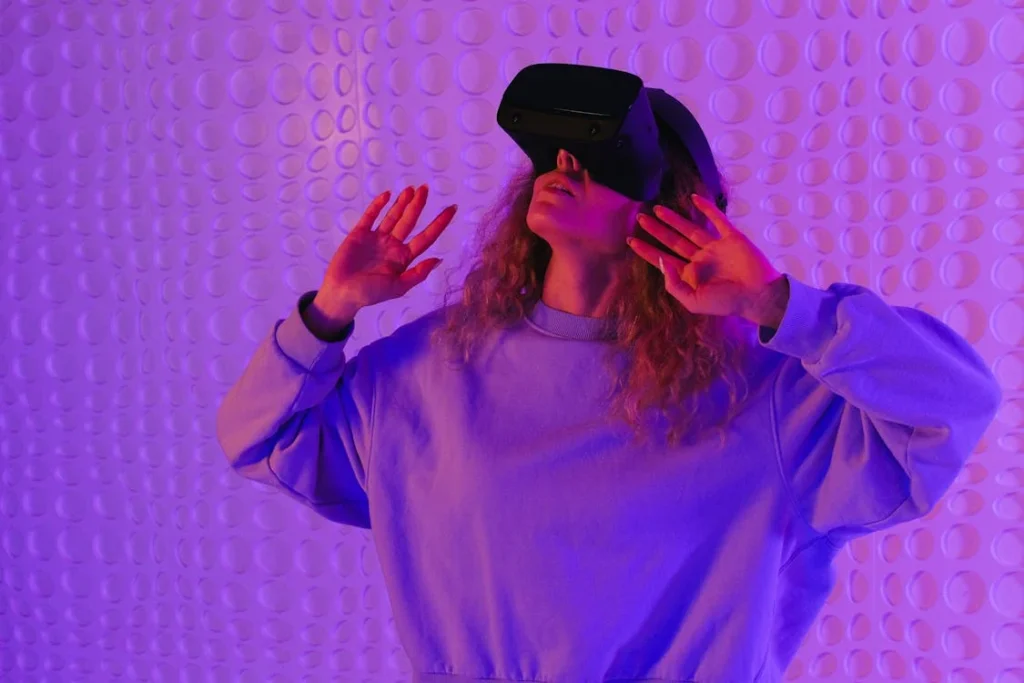Gait rehabilitation has come a long way. Not long ago, recovery after limb loss or injury was limited to physical sessions, parallel bars, and manual techniques. While these methods helped, they also had their limits. Today, technology is changing everything.
Virtual Reality (VR) and Artificial Intelligence (AI) are bringing new hope to people learning to walk again. They’re making therapy more engaging, more accurate, and more personal. At Robobionics, we’ve seen first-hand how these tools are helping people recover faster and with more confidence.
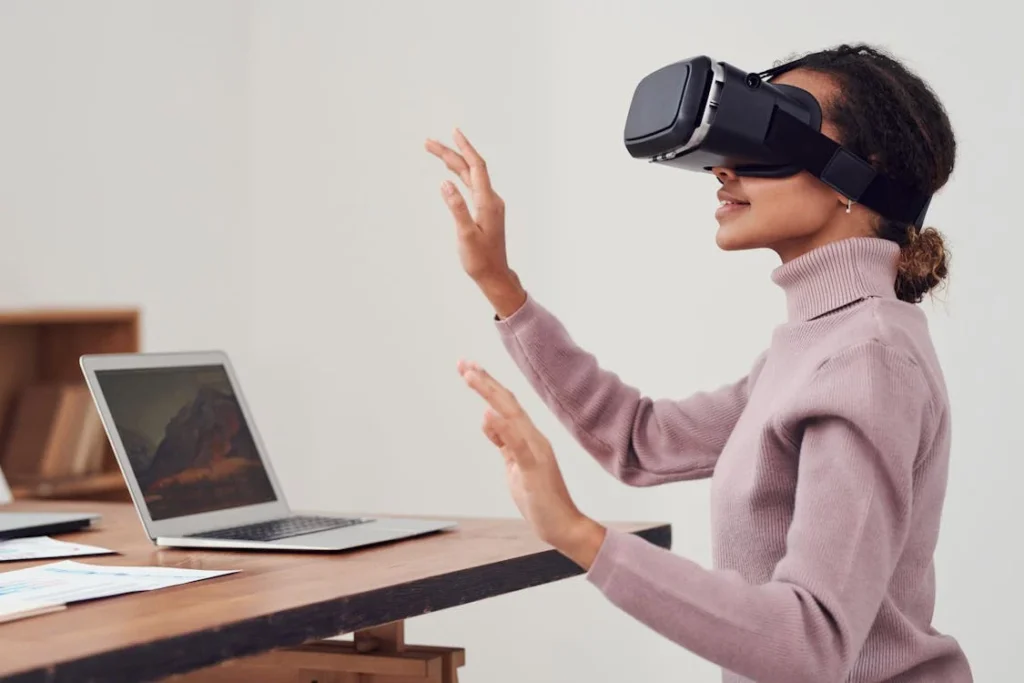
How Virtual Reality is Changing the Way We Walk Again
From Boring Repetition to Engaging Environments
One of the biggest challenges in gait rehabilitation is motivation. Doing the same exercises over and over—walking straight, balancing, turning—can become boring. Patients often feel like they’re not making progress. That’s where Virtual Reality (VR) brings a huge change.
VR transforms a simple walk into an experience. Imagine you’re walking through a forest path, crossing a wooden bridge, or navigating a quiet village street. You’re not just walking anymore—you’re interacting with a digital world. But this isn’t just for fun. These environments are carefully designed to mimic real-life scenarios. Uneven ground, slight slopes, unexpected turns—all things people face in daily life—are built into these virtual spaces.
As you walk through them wearing a VR headset, your brain starts learning how to adjust. Your body becomes more alert. And most importantly, you start enjoying the process. This emotional engagement can often push people to train longer, with more focus and less frustration.
We’ve seen patients who used to dread walking practice begin to look forward to their sessions just because of the VR experience. The change in attitude alone speeds up recovery.
Building Confidence Through Safe Challenges
Real-world walking is unpredictable. Crowded markets, moving buses, sudden obstacles—these situations can be terrifying when you’re still learning to walk with a prosthetic. VR allows patients to practice for these moments in a completely safe environment.
In one training session, a patient may learn how to turn corners quickly. In another, they may practice walking in a crowd or crossing a busy road. If they trip or stumble, there’s no risk of injury. But the lesson remains powerful. Each challenge builds reflexes, coordination, and trust in the prosthetic limb.
We worked with a patient named Ravi who had not left his house in over a year. He was afraid of walking in public. We started him on VR walking simulations inside our clinic. Within three weeks, his posture improved. Within six weeks, he was walking to the local grocery store with his son. His words: “I trained my fear before I trained my feet.”
This kind of emotional training is just as important as physical movement. VR lets people fall, recover, and grow—all without risk.
Real-Time Feedback That Speeds Up Learning
Traditionally, gait therapists watch a patient walk and then point out corrections—stand straighter, shift weight, or take even steps. This works, but it can be slow and limited by what the human eye can catch.
With VR, we can do better. Many VR rehabilitation systems are now equipped with motion sensors. These sensors track every part of the body—how high you lift your leg, how fast you move, how evenly you shift your weight. All this data is shown in real-time on the screen or VR interface.
That means if your left step is shorter than your right, you’ll know immediately. If you’re leaning too much on one side, the system alerts you. This kind of instant feedback helps you make changes in the moment—not a day later, not after another session.
You learn faster, because your brain gets faster input.
We had a patient, Meena, who struggled with uneven steps. Her therapist used to give corrections after each walk, but progress was slow. Once we introduced VR, the system showed her exactly where the difference was—live, as she walked. Within four days, her stride was nearly even.
That’s the power of seeing your mistake as it happens—and fixing it right there.
A Personalized Training Journey
Everyone walks differently. Everyone learns at their own pace. One of the biggest advantages of using VR is that it can be tailored to each person’s needs. If someone has trouble with stairs, their virtual session can include more stair climbing. If balance is a bigger issue, the environment can include tricky surfaces that challenge their stability.
At Robobionics, we use VR to customize therapy plans for every individual. The system learns what you’re good at and what you need more help with. As you improve, the difficulty automatically increases. That keeps your brain and body growing—without feeling overwhelmed.
One of our patients, Shalini, loved walking but feared slopes. Her VR sessions included a slow hill at first. As she got better, the slope became steeper. After three weeks, she was walking up the real slope outside our clinic with confidence.
This gradual, smart approach makes therapy more effective and less stressful.
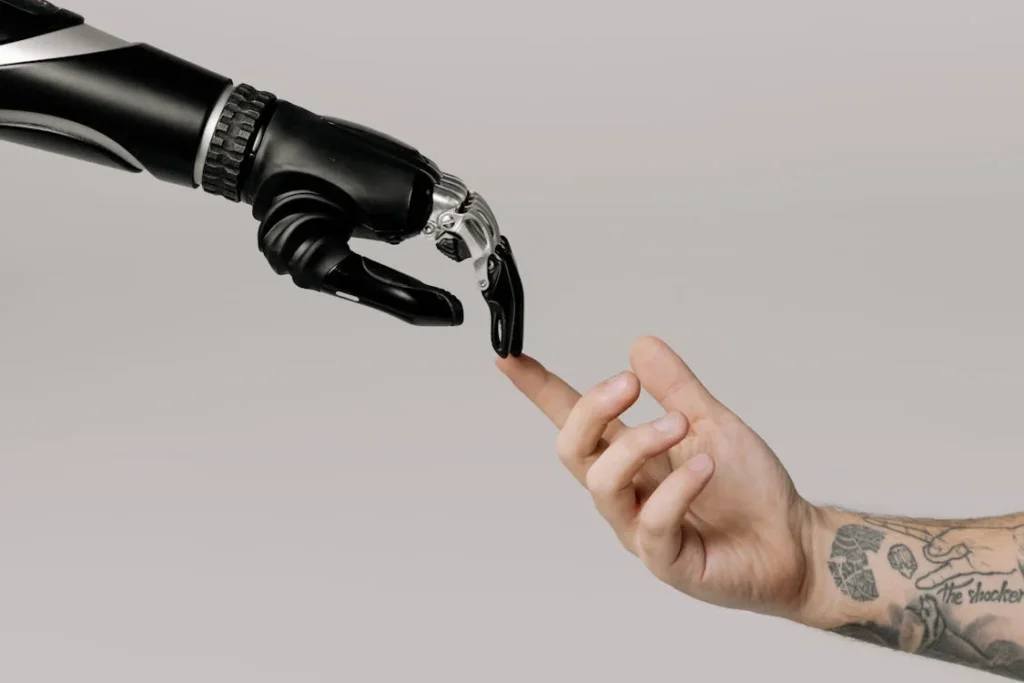
How Artificial Intelligence Is Revolutionizing Gait Rehabilitation
Smart Analysis That Sees What Humans Can’t
Artificial Intelligence (AI) is like a super assistant for therapists. It watches, learns, and understands movement in ways even the most trained eye can miss. In gait rehabilitation, this means more precise feedback, faster problem-solving, and better results for patients.
When someone walks with a prosthetic, their movements are often uneven in the beginning. Maybe one leg moves faster. Maybe the hips shift too much. These imbalances might be subtle—but they matter. If they go unchecked, they can cause pain or long-term posture issues.
AI uses sensors, cameras, and algorithms to track every detail of your movement. It doesn’t just look at your steps—it measures angles, speed, stride length, pressure, and timing. Then, it compares this data to thousands of walking patterns from people of similar height, weight, and condition.
Within seconds, AI can tell whether you’re leaning too far forward, pushing off incorrectly, or landing too hard on your heel. It gives this data to your therapist, who can then adjust your training instantly.
This kind of precision helps therapists move from guessing to knowing. For the patient, it means fewer setbacks and more rapid progress.
Personalized Learning Through AI
Not everyone responds to therapy in the same way. Some people learn quickly, others take more time. Some need more practice with balance. Others struggle with stamina. AI makes it easier to adjust to each individual.
At Robobionics, we work with AI systems that learn from the patient’s performance. If you’re making good progress, the AI increases your challenge gradually—longer walks, sharper turns, quicker reactions. If you’re struggling, it slows down, offering simpler paths or more support.
This adaptive learning is powerful. It keeps patients in the “sweet spot” of progress—not too easy, not too hard. And that’s where real growth happens.
We once had a patient named Harish who had a habit of dragging his prosthetic foot. It was subtle but affected his whole gait. Traditional therapy wasn’t solving it. When we introduced AI-powered motion analysis, it spotted that Harish wasn’t engaging his hip muscles properly on one side. With this information, we changed his training focus—and within two weeks, the dragging stopped.
AI didn’t just make a guess. It gave us a solution.
Predicting Issues Before They Become Problems
One of the most exciting things about AI in rehabilitation is its ability to predict. Because it learns from massive amounts of data, AI can detect small changes that might signal a future issue.
Let’s say you’ve been walking well for weeks, but recently, your weight shift pattern has changed slightly. A therapist might not notice it right away—but an AI system will. It can alert your team before discomfort or pain even starts.
This allows therapists to make early changes—maybe adjusting your prosthetic fit, changing your shoe type, or modifying your training plan.
For patients, this means fewer injuries and smoother recovery. It also means more trust in the process. You’re not waiting for something to go wrong. You’re staying ahead of the problem.
AI and Emotional Understanding
Yes, AI is mainly about numbers and patterns—but it’s also beginning to understand emotions. Some newer systems now track facial expressions, tone of voice, and even breathing patterns during therapy. This helps them understand how a person is feeling while they train.
Why does this matter?
Because walking again isn’t just physical—it’s emotional. If someone is anxious or scared, their body will move differently. They may tighten up, take shorter steps, or lose balance. If the AI picks up signs of stress, it can pause the session, suggest a break, or switch to a more relaxed activity.
This emotional awareness adds a gentle, human-like support layer to technology. It’s not just tracking how you walk—it’s checking how you feel while walking.
We had a young patient named Zoya who became nervous during gait training when sessions lasted too long. The AI noticed a drop in her step rhythm and an increase in heart rate. It recommended shorter, more frequent walks. Her comfort improved almost immediately, and her progress continued without stress.
AI and Tele-Rehabilitation
Another big advantage of AI is remote access. Not everyone can visit a clinic every day. With AI-powered systems, patients can now train from home with digital support.
Using a smartphone camera, wearable sensors, or even a home treadmill with AI tracking, patients can complete exercises from wherever they are. The system checks their movements, gives real-time corrections, and sends updates to their therapists.
This kind of home rehabilitation is becoming more common—especially in rural areas or during times when travel is difficult. It keeps patients engaged without breaking their routine.
In one case, an elderly patient from a remote village in Karnataka used an AI-powered tablet system to continue gait rehab at home. His daughter helped set it up. The system guided him through exercises, offered corrections, and sent weekly progress reports to our team. When he visited us again after a month, his improvement was clear—he was walking with better balance than ever before.
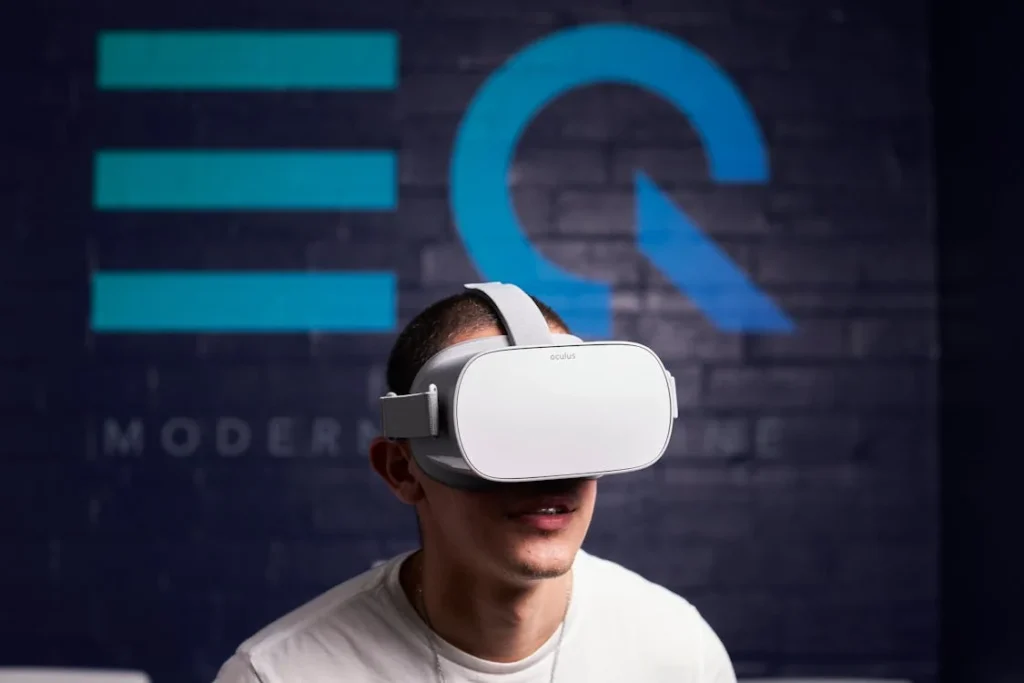
The Power of Combining VR and AI in Gait Rehabilitation
When Technology Works Together, Recovery Moves Faster
Individually, both Virtual Reality (VR) and Artificial Intelligence (AI) offer powerful support in gait rehabilitation. But when they come together, the impact multiplies. At Robobionics, we’ve seen this combination transform therapy into something deeper, smarter, and more human-like.
VR offers immersive, lifelike environments that challenge and engage the body. AI watches how the body reacts to those environments, tracks every detail, and helps both patient and therapist make better decisions. It’s like walking in a virtual world while being guided by a silent coach who knows exactly what to do next.
One without the other is helpful. Together, they create a breakthrough.
A Training Experience That Feels Real—and Gets Real Results
Imagine this: You’re wearing a VR headset. You’re walking across a digital bridge in a park. Trees sway, birds chirp, and the ground beneath your feet changes. It feels real. But while you’re walking, sensors on your hips, legs, and feet are feeding data into an AI system. The AI watches your stride length, balance, and timing.
If your right foot lands slightly earlier than your left, the AI flags it. If your posture leans forward too much, it suggests a correction. All of this happens in real-time. The virtual environment may gently change—adding a small slope or curve—to test your balance in a new way.
This is not just a session. It’s smart, responsive, and dynamic therapy.
We’ve seen patients improve twice as fast using this combined approach. Why? Because they stay more focused, receive instant feedback, and enjoy the process more.
Making Rehab Accessible to More People
At first, people assume that VR and AI therapy must be expensive or limited to advanced hospitals. But that’s changing quickly. The cost of VR headsets has dropped. AI software is now being designed for use on tablets and smartphones. And at Robobionics, we’re working on portable systems that can be used in small clinics, rehab centers, and even homes.
We believe recovery tools should never be a luxury. Every person deserves access to the best support possible—whether they live in a metro city or a rural village.
One project we’re especially proud of is our Mobile Gait Rehab Kit. It includes a lightweight VR headset, wearable sensors, and a basic AI-powered tablet. This setup allows local therapists to deliver high-quality, tech-supported therapy sessions in areas where such tools never existed before.
In one small town outside Nagpur, we trained two community health workers to use this system. They now run regular rehab sessions for patients who otherwise had no access to guided gait therapy. Patients don’t need to travel far or wait for specialists. They walk into a room, wear a headset, and begin training—guided by tech that adjusts to them, not the other way around.
Encouraging Independence and Self-Learning
The best rehabilitation doesn’t just fix a problem. It teaches a person how to help themselves. That’s what VR and AI do beautifully—they allow patients to take ownership of their progress.
With traditional therapy, patients often rely entirely on the therapist’s voice. But with AI-guided sessions, the system tells them how they’re doing. They see numbers, visuals, and improvements on-screen. In VR, they walk through challenges on their own. They explore. They decide.
This builds a powerful sense of independence. Patients begin trusting their own instincts. They become more aware of how their body moves. They feel proud—not just because they walked—but because they figured out how to improve.
We had a patient named Sumit, an engineering student, who loved learning. Once introduced to the AI-VR system, he started setting his own challenges. He tracked his data, read up on biomechanics, and even created his own progress charts. His enthusiasm turned rehab into something personal—and deeply effective.
Keeping the Human Touch in a Tech World
One concern people often have with advanced technology is the fear of losing the human element. Will a machine replace the therapist? Will rehab feel cold and robotic?
The answer is no.
In our practice, technology doesn’t replace human care—it enhances it. The therapist is still at the center of the process. AI gives them sharper tools. VR gives them a richer setting to work in. But it’s still the therapist’s eyes, hands, and heart that guide the journey.
And the patient still receives encouragement, understanding, and emotional support from real people. The tech is there to make every session smarter—not to take over the healing process.
This balance matters deeply to us. At Robobionics, we don’t chase technology for the sake of looking modern. We use it to serve people better. To reach more patients. To help more families. And to make the long, hard walk of recovery a little easier, a little more joyful, and a lot more successful.
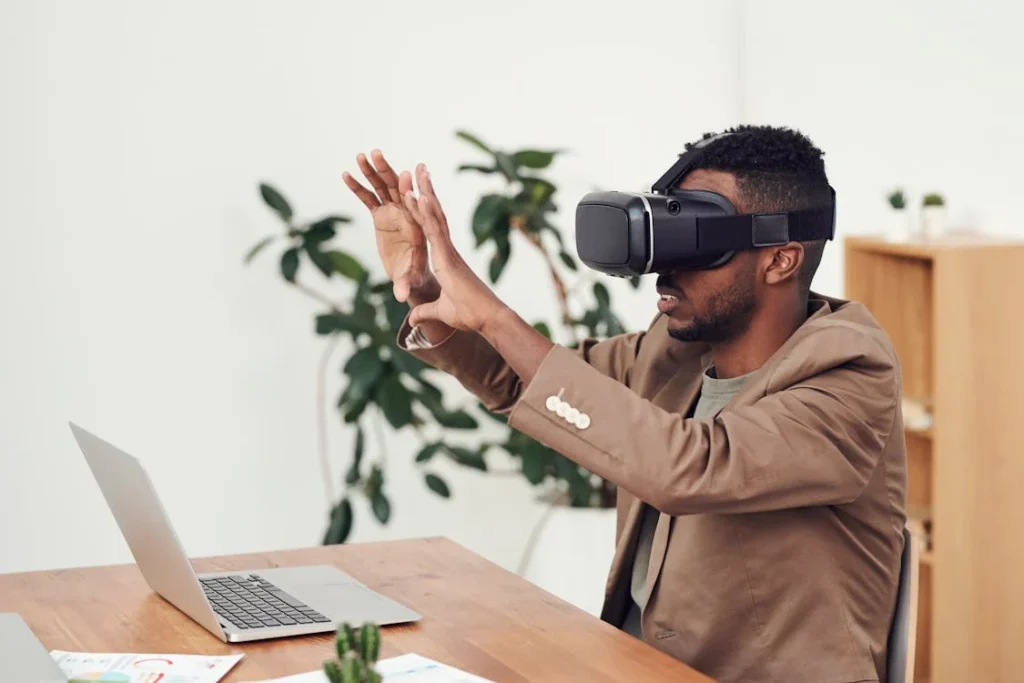
Real-Life Success Stories: How VR and AI Are Changing Lives at Robobionics
Meera’s Journey: From Wheelchair to Market Walks
Meera, a 58-year-old retired schoolteacher, came to us two years after her below-knee amputation. She had spent most of that time in a wheelchair, too afraid to try walking again. Her confidence had dropped, and she avoided leaving home. Her biggest fear wasn’t pain—it was falling.
We started Meera with simple VR sessions. She walked along calm digital beaches, with soft waves and clear skies in her headset. It was peaceful. But more importantly, it was safe. The AI quietly tracked her steps and balance. The moment she leaned too far or hesitated, it offered instant corrections—spoken gently by the system and reinforced by her therapist.
What made the biggest difference was her smile. Meera began looking forward to sessions. She described them as “a walk without fear.” Week by week, her walking improved. Her AI-generated reports showed longer strides, better symmetry, and smoother transitions from standing to walking.
Within six weeks, she was walking down her lane to buy vegetables again. The same woman who once said “I can’t even walk to the kitchen” now proudly walks through a busy local market, holding her own shopping bag.
Ajay’s Story: Turning Recovery into Independence
Ajay, a 33-year-old auto mechanic from Pune, lost his right leg in a road accident. He was active, strong, and used to standing for hours at work. Losing his limb crushed him—not just physically but emotionally. He thought he would never go back to his garage.
His training began with standard gait therapy. But Ajay was restless. He wanted to be challenged. So we introduced him to our AI-VR rehab model. He was placed in virtual garage environments—filled with tools, narrow spaces, even a lift. The AI tracked how he balanced while bending, how he shifted weight while picking up tools, and how his prosthetic handled sudden turns.
He loved it.
His natural skill as a mechanic kicked in. He began testing the system. “What happens if I reach down fast?” “What if I twist suddenly?” Each action gave real feedback—showing him how to do it better. It became his new workshop. And in that space, Ajay didn’t just walk again. He worked again.
Six months later, Ajay reopened his garage. He greets every customer standing tall. His words: “I didn’t just get my leg back. I got my work back. My life back.”
Rekha’s New Beginning: Age Is Just a Number
At 72, Rekha was our oldest patient to try AI-assisted VR gait rehab. A former yoga instructor, she had a transfemoral amputation due to complications from a fall. Many believed her age would slow her recovery. Rekha didn’t agree.
Her goal was to be able to climb stairs again—specifically, the stairs to her temple.
VR made her therapy less intimidating. She practiced walking in serene, spiritual digital landscapes that resembled her favorite places. The AI gently corrected her stance and step timing. She didn’t just walk—she walked with grace.
By the end of her training, she was not only climbing stairs but doing short yoga movements for balance. Her gait reports, once shaky and uneven, showed near-perfect alignment.
When asked what helped her most, she said: “This system gave me my rhythm back.”
These stories aren’t rare at Robobionics. They are becoming the norm.
What’s Next: The Future of Smart Gait Rehabilitation
As we look ahead, the future of gait rehab is even more promising. At Robobionics, we’re working on systems that will integrate machine learning, augmented reality, and biofeedback into daily walking therapy.
We envision a world where patients wear lightweight AR glasses instead of bulky VR headsets—where walking along a real street overlays digital cues, showing corrections in real-time. We are exploring AI that doesn’t just learn from one patient—but from thousands—making each session smarter for everyone.
We’re also testing wearable sensors that give feedback on heart rate, fatigue, and hydration during gait therapy. This makes rehab more holistic, addressing the full person, not just the walking motion.
And most exciting of all—we’re developing ways to connect patients from all over India. Imagine a virtual rehab room where patients from Lucknow, Bengaluru, and Guwahati train together, encourage each other, and share real-time progress through AI dashboards. Gait recovery can become a community event, not a lonely journey.
Bringing It All Home
All these innovations are exciting—but what matters most is that they work. They help real people. They make recovery feel possible. And they turn hard, emotional journeys into inspiring stories of strength.
Whether you’re a therapist, a patient, a caregiver, or someone simply curious about the future of recovery—know this: the world of gait rehabilitation is being redefined. One smart step at a time.
At Robobionics, we’re proud to be part of that change. And we’re just getting started.
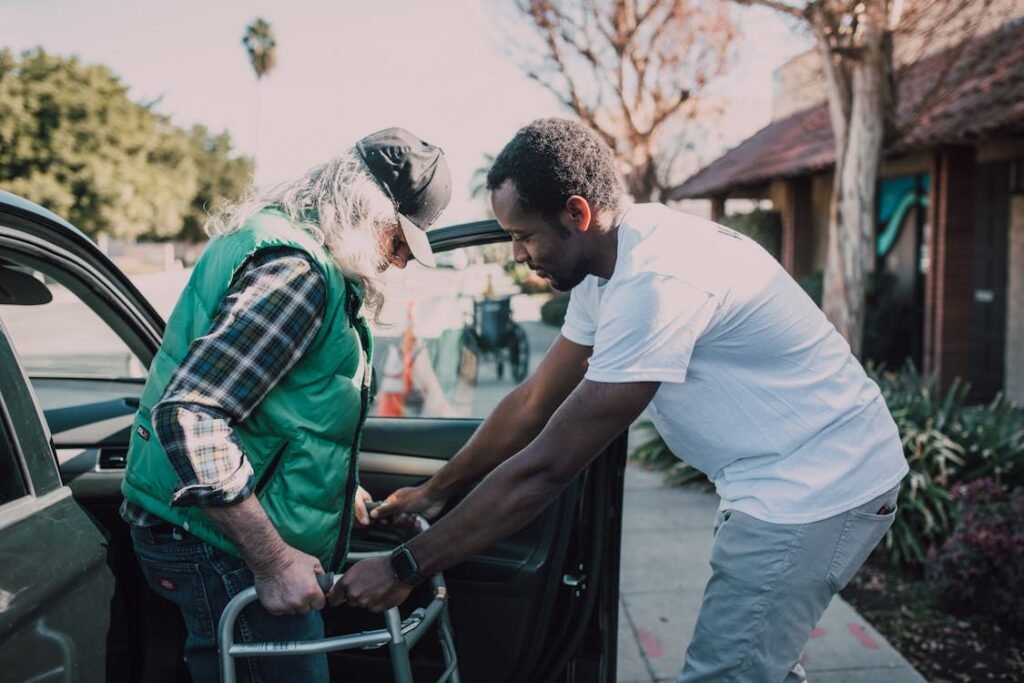
How Caregivers and Families Can Use VR and AI to Support Gait Rehabilitation
More Than Just Observers
When someone is recovering from limb loss or learning to walk again, the people around them—family members, friends, and caregivers—play a critical role. Traditionally, their involvement has been limited to offering physical support or emotional encouragement. But with Virtual Reality (VR) and Artificial Intelligence (AI) becoming part of gait rehabilitation, families now have new ways to help, learn, and even participate in the journey.
Instead of standing on the sidelines, loved ones can now take a more informed and active role in therapy. At Robobionics, we’ve seen how this involvement strengthens both the recovery process and the emotional bond between patient and caregiver.
Learning the Process Together
One of the biggest challenges for caregivers is not knowing what to expect. They see their loved one struggling with therapy but don’t always understand the purpose behind each step. When VR and AI are introduced, the entire process becomes more transparent.
Many of the systems we use provide real-time data and visual feedback—not just for the therapist and patient, but also for family members. A caregiver can sit nearby and watch how their loved one is walking through the virtual world. They can see where the AI detects imbalance or incorrect posture. This shared understanding changes everything.
When both the patient and caregiver are “seeing” the same data, the support becomes more meaningful. The encouragement becomes more specific. Instead of saying, “You’re doing great,” a caregiver might say, “Your left step looked smoother today, just like in the practice yesterday.” That kind of informed support is incredibly motivating.
At-Home Practice Made Smarter
Once patients leave the clinic, much of their progress depends on home practice. But this can be hard to manage without professional guidance. With AI-powered systems and VR training modules now available in more portable formats, caregivers can actively assist with these at-home sessions.
We’ve developed easy-to-use tools that require no technical background. A family member can help set up a VR headset or place wearable sensors on the patient before practice. They can monitor sessions using a companion app that tracks movements, flags errors, and even suggests improvements.
This doesn’t just help the patient—it empowers the family. Instead of feeling helpless, they feel involved. They become part of the recovery team.
We worked with a young man named Ravi who lived with his elderly father. Ravi had a below-knee amputation and was training with a home-based AI gait system. His father, despite being unfamiliar with technology, learned how to operate the system. He even began adjusting furniture at home to match the training environments from the VR simulations. That kind of support accelerated Ravi’s progress dramatically.
Emotional Benefits of Shared Experience
Recovery is not just physical—it’s deeply emotional. There are good days and hard days. Having someone beside you who truly understands what you’re going through can make all the difference. VR and AI systems create opportunities for shared experiences that are otherwise hard to come by in traditional rehab.
Some of our VR modules now allow for “paired sessions,” where a caregiver and patient can walk through the same virtual environment together—either physically side-by-side or through synchronized screens. They might walk a virtual garden path, climb temple stairs, or navigate a simulated shopping trip. These moments aren’t just therapy—they’re memories.
We’ve seen how this strengthens relationships. Parents and children, spouses, siblings—they all get to celebrate small victories together. They laugh at missteps, cheer for improvements, and feel more connected through the process.
One of our patients, Aarti, trained with her teenage daughter by her side. They walked through a virtual trek route together—Aarti on her prosthetic, her daughter as a supporting observer. When Aarti reached the peak of the simulation, her daughter cried. “It felt like we climbed that mountain together,” she said. And in a way, they had.
Educating and Empowering the Support System
Lastly, VR and AI don’t just help with training—they help with education. Our systems offer tutorials and simple explanations for families. They explain gait patterns, prosthetic adjustments, and even how to prevent falls at home. Caregivers can learn how to spot signs of discomfort or fatigue early, how to encourage without pushing too hard, and how to help without overstepping.
When families are educated, they feel less anxious and more prepared. And when they’re empowered, the patient feels safer and stronger. It becomes a shared journey, not a solitary one.
At Robobionics, we always say: recovery doesn’t happen in isolation. It happens in connection. VR and AI are not just smart tools for walking—they are bridges that bring people closer during one of life’s toughest transitions.
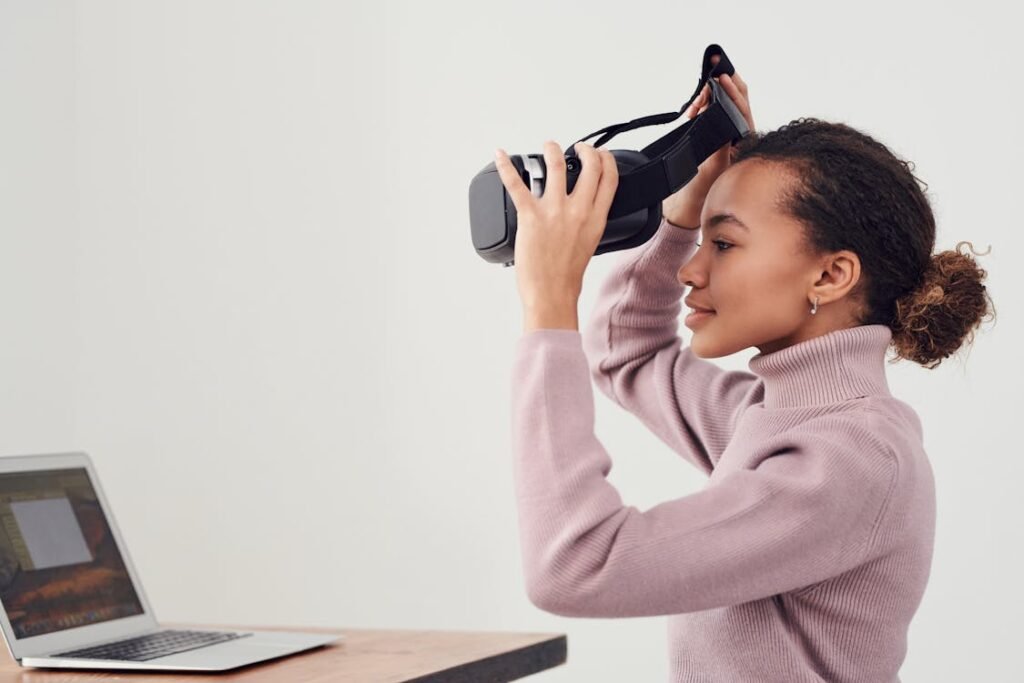
Cultural Acceptance of Tech-Driven Therapy in Indian Households
Blending Tradition with Innovation
India is a country deeply rooted in traditions. Family values, spiritual practices, and cultural customs shape how we view health, recovery, and daily life. So, when advanced technologies like Virtual Reality (VR) and Artificial Intelligence (AI) enter the picture—especially in something as personal as rehabilitation—they bring not only new possibilities but also new questions.
At Robobionics, we’ve seen that while the science behind VR and AI is cutting-edge, its success in India depends heavily on how well it fits into the cultural context of each family. And surprisingly, when introduced with care and clarity, even the most traditional households begin to embrace these tools with open arms.
The Initial Resistance
For many families, especially in rural or older urban areas, the idea of someone wearing a headset or being guided by a machine during therapy feels strange. Some see it as “too modern.” Others wonder if it’s necessary at all. After all, walking has always been learned by practice, not by screens.
This hesitation is normal. It comes from a place of caution and unfamiliarity—not rejection. What often helps is starting the conversation from a place of shared values. When we explain that these technologies don’t replace traditional therapy but actually enhance it, acceptance begins to grow.
We relate the structured feedback of AI to how elders once corrected posture during prayer or yoga. We compare the immersive nature of VR to visualization techniques used in meditation. Slowly, the family sees that the core principles—focus, repetition, feedback—are very much in line with Indian ways of learning.
A New Kind of “Home Remedy”
Indians are deeply connected to the idea of home-based healing. Whether it’s using turmeric for wounds or oil massages for pain, there’s great trust in remedies that can be practiced under one’s own roof.
Once families understand that VR and AI can now be used at home—with no need for daily hospital visits—they start to see these tools as the “next-gen home remedy.” Suddenly, the prosthetic user isn’t dependent on a hospital or a physiotherapist every single day. They have tools they can trust right at home. That shift brings a sense of independence that aligns well with family values.
We’ve had families who began with reluctance. But after watching a loved one train using a headset and sensors in the living room—and seeing the clear improvements within weeks—they became the strongest advocates. In fact, some grandparents in the house even became curious and wanted to try the VR headset themselves.
Respect for Authority and the “Doctor’s Word”
In Indian culture, doctors and therapists are often viewed with great respect. Their word carries weight. That’s why how the technology is introduced—and by whom—makes all the difference.
When VR and AI tools are explained directly by the clinical team, using simple language and visuals, families listen. We often demonstrate a session with the patient, allowing the caregiver to watch. When they see real-time corrections, hear the encouraging tone of the virtual environment, and watch their loved one walk confidently—they begin to trust the process.
We’ve also made sure to provide our therapy summaries in regional languages. Whether it’s Marathi, Tamil, or Bengali, when families can read progress reports in a familiar script, the tools feel more accessible, more local, and less foreign.
Faith and Familiarity
Faith plays a strong role in Indian recovery journeys. People often tie recovery to divine timing, blessings, or spiritual strength. We never position technology as a replacement for these beliefs. Instead, we present it as support—something that works alongside faith, not against it.
In fact, we’ve tailored some of our VR environments to reflect Indian settings. A walk through a temple courtyard, a path lined with diya lamps, a village road during a festival—these details help patients feel grounded. The more the therapy reflects their reality, the more they accept it.
This blend of tradition and tech creates a new model of care: one that’s scientifically advanced but emotionally and culturally sensitive.
Changing Perception, One Family at a Time
We don’t expect overnight change. But what we do see is powerful: one family tells another. One son records a video of his mother using AI feedback at home and shares it on WhatsApp. One patient talks about VR therapy in a village community meeting. Slowly, what seemed modern and strange becomes the new normal.
At Robobionics, we’ve learned that introducing technology into Indian homes isn’t just about the machine—it’s about the message. When we respect culture, speak the right language, and involve the entire family, acceptance follows. And with it, faster, more joyful healing.
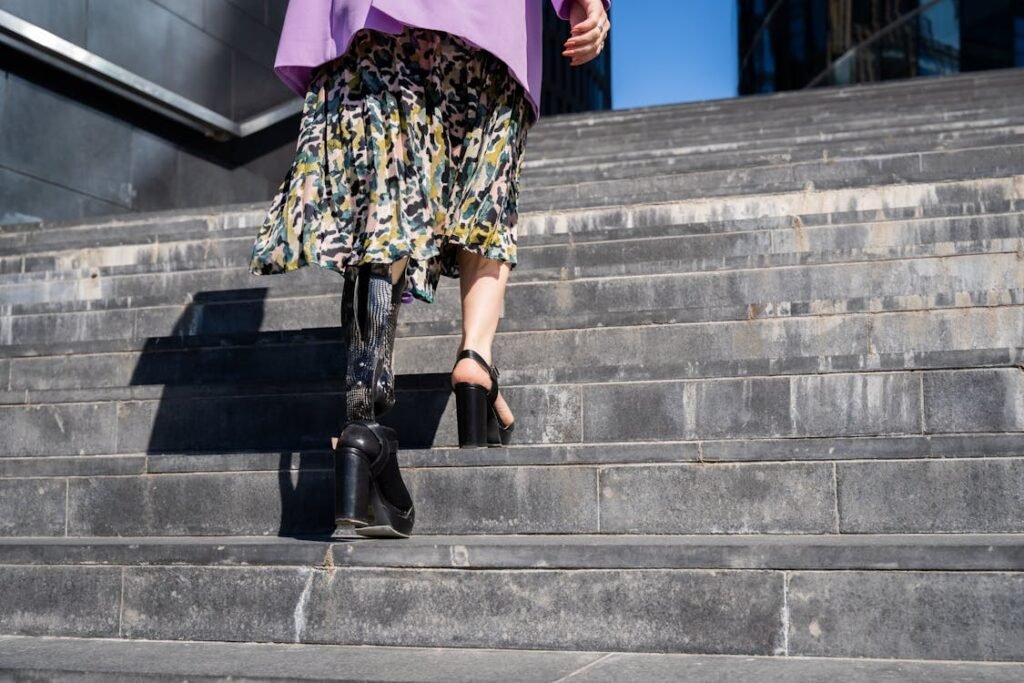
Designing VR for Low-Literacy and Multi-Language Users in India
Meeting People Where They Are
India is a country of many voices, cultures, and educational backgrounds. In gait rehabilitation, one major challenge we’ve encountered is ensuring that new technologies like Virtual Reality (VR) and Artificial Intelligence (AI) are usable and accessible for people who may not speak English or have high literacy levels.
A prosthetic user shouldn’t need to be tech-savvy or fluent in English to walk again with confidence. At Robobionics, we believe it’s not enough to develop smart solutions—they must also be simple, inclusive, and respectful of the people who use them.
Designing for real-world users—farmers, home-makers, workers, elders—means designing for diversity.
Making Interfaces That Speak Their Language
Many early VR rehab systems were designed in Western countries, with instructions in English, accents not familiar to Indian ears, and cultural references that didn’t connect. This made many users hesitate. If the system feels like it wasn’t made for you, trust becomes difficult.
To solve this, we’ve worked hard to localize our technology. That means offering audio and on-screen instructions in multiple Indian languages. Marathi, Hindi, Tamil, Kannada, Bengali—these are not add-ons. They’re essential.
When a user hears a calm, clear instruction in their mother tongue, something shifts. They feel safe. They feel seen. And they engage with the session more fully.
One of our patients, an elderly woman named Indumati from a village in Gujarat, was hesitant to wear the headset. But once she heard the instruction say, “Aapka pehla kadam bada sundar hai” (“Your first step is very graceful”), she smiled. From that moment, she trusted the system.
We’ve also worked with voice modulation to make the guidance sound respectful and warm—more like a conversation than a command.
Designing for Visual Simplicity
Not every patient can read or interpret complex visual data. Graphs, charts, and progress meters can be confusing if presented the wrong way. That’s why we’ve redesigned our interfaces with visual simplicity in mind.
We use symbols, colors, and motion to communicate key messages. For instance, a glowing green foot under a character in the VR world means “good step.” A red pulse means “pause and correct.” Smiley faces, animated claps, and glowing paths are more effective for many users than abstract numbers.
In this way, even patients who can’t read or write can understand how they’re doing and what to change. Feedback becomes visual and intuitive.
We’ve even replaced the concept of “score” with “growth.” Instead of showing 78%, we show a digital flower blooming or a diya lighting up—symbols that make more emotional sense and build confidence.
Low-Tech, High-Impact VR
We understand that not every household has the latest phones or high-speed internet. So we’ve developed lightweight, app-based VR systems that can run on basic smartphones. These systems use cardboard headsets, pre-downloaded sessions, and Bluetooth sensors.
The goal is not to impress with complexity—it’s to empower with simplicity.
In a pilot program in Odisha, we trained Accredited Social Health Activists (ASHAs) to deliver VR-assisted gait training using just a basic phone, headset, and wearable strap sensors. Within two weeks, local users were practicing daily—and without needing to read a single instruction.
This model is especially helpful in areas where both digital access and literacy are limited. The patient receives feedback in their own language. The caregiver understands the setup. And the community health worker becomes the bridge between tradition and technology.
Respecting the Learning Curve
Introducing any new technology must be done with patience. In our clinics and outreach centers, we don’t just hand over the device—we demonstrate it, we explain it, and we sit with the user during the first few sessions. Often, a single supportive experience is enough to turn hesitation into confidence.
We also encourage families to try the tech themselves. When a grandson helps his grandfather put on a headset and both of them laugh at the experience, it’s no longer a medical tool—it’s a moment of bonding.
Over time, users grow curious. They want to know how many steps they took. How many turns they completed. Which session is next. The learning happens naturally—because the design makes it feel natural.
Technology Without Barriers
At Robobionics, we believe that access to good therapy should not depend on language, literacy, or education. Everyone has the right to walk with pride and dignity—whether they’re fluent in English or have never touched a smartphone before.
Our mission is to keep improving how we build these tools. To listen more, test more, and remove every unnecessary barrier. Because the best technology isn’t just advanced. It’s invisible. It feels so human, so intuitive, that anyone can use it—regardless of who they are or where they come from.
Conclusion
Virtual Reality and Artificial Intelligence are no longer futuristic tools—they are real, working solutions transforming how we help people walk again. At Robobionics, we’ve seen how these technologies don’t just improve gait—they build confidence, independence, and dignity.
From smart sensors that guide each step to immersive environments that turn rehab into an experience, the journey is no longer cold or clinical. It’s personal, empowering, and culturally sensitive. Whether someone is from a city or a small village, literate or not, young or elderly—these tools are being shaped to serve everyone.
The future of gait rehabilitation isn’t about replacing the human touch. It’s about enhancing it. Making recovery faster, smarter, and more meaningful.
With each new step powered by innovation, we’re proving one thing: walking again isn’t just possible—it can be joyful, dignified, and truly life-changing. And at Robobionics, we’re proud to walk that journey with you.



